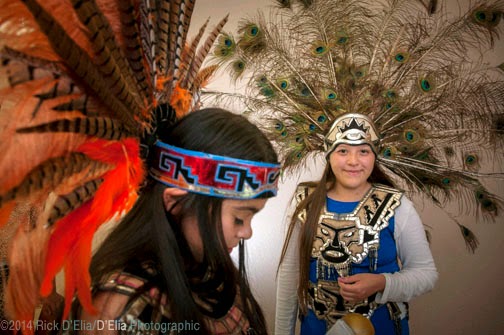 |
| The primary players, as Juan Diego, Mary(Guadalupe), and Friar, giving a sense of the time of the event in the 1500's but with a hint of modernity in the corner. |
Their goal was to improve their coverage of hispanic/latino issues and culture and have a more diverse collection of appropriate images when discussing various matters in their blogs, news pages and other collateral materials.
 |
| Final costume adjustments. |
While a major goal of this project was to document the unfolding of a religious and cultural event, we were also searching for moments, faces. It got me thinking about Richard Avedon's iconic use of plain backgrounds throughout his life, to create images that were more about the faces than anything else.
It led to a couple of opportunities to try something new to my NGO-style of work. Although I like to use environments for my portrait background, I wondered if this idea could fit with CRS' needs. Try new things to figure out if they fit.
 |
| "Juan Diego" |
Of course, I covered the events themselves with the thoroughness that I try to bring to all of my work (I'll sleep when I get home!), but the portraits added an interesting additional dimension to the package.
 |
| Reenactment, Juan Diego walks a path from his village. |
 |
| In the reenactment, Mary appears to Juan Diego. |
 |
| Aztec dance celebration begins. |
Once they completed their performance, I felt there might be an opportunity to deepen my coverage of the group, deciding to borrow that page from Avedon's book and photograph some of the dancers on a simple background, if I could find a space in the banquet hall next door amid the expanse of tables that had been set up for a post-Mass meal.
We carved out a little corner of the hall, moving a table to the side to clear a space, and, using a simple set-up of two camera strobes, one bouncing off the white sidewall and ceiling and one providing a wash on the background wall to eliminate back shadows, we made a series of simple portraits showing young faces and the vibrant, feathered costumes of the traditional dancers.
The experiment was a great success, with some simple beautiful images thate were well received in all of the departments at CRS who would need the images to communicate their messages. An experiment, the simple idea provided some bonus depth to a collection from only two days of intense shooting.
 |
| Giving out roses to all for the ladies in attendance. |
 |
| Young Aztec Dancers |



Comments